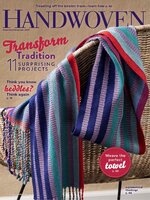Each issue offers a stunning collection of enticing weaving projects. But the magazine is more than that: it's a pattern book, and weave structure textbook, it's a place to discover original designs, and find solutions to weaving challenges. For over 20 years Handwoven has been an indispensable resource for weavers.
FROM THE EDITOR
FUTURE THEMES
Handwoven • SEPTEMBER/OCTOBER 2022, Volume XLIII Number 4
Letters • Stories, tips, tricks, and questions from Handwoven readers
Project Index
Favorite Finds • Stake your claim, whether it’s on your work or your tools. Mend with style and rip seams with élan with these products intended for the sewist in us all.
Creative Treadling with Overshot: Explorations in Weave Structure & 36 Projects
Tapestry Design Basics and Beyond: Planning and Weaving with Confidence
For the Love of Weaving: Devon Weavers Workshop • The concept of what would eventually become Devon Weavers Workshop was dreamt up by six of us. We were all enthusiastic (once-a-week) weavers who met at a weaving course in the mid-1980s. After the death of our teacher in 1991, we carried on as a “self-help” group until we eventually lost our meeting space in 2001 after a long and protracted battle. Despite desperate attempts to find other affordable accommodations, we ended up in a friend’s granny flat with hardly enough room to throw a shuttle, let alone a cat, but we remained as determined as ever to carry on.
Best Practices Interpreting Drafts • The weaving draft is a clever way of giving a weaver a lot of important information in a compact format. The L-shaped threading, tie-up, and treadling draft is the standard for most modern weaving projects, but even within this familiar shape, there can be many differences. As such, it’s important when encountering a new draft to orient yourself. The “L” can be rotated in myriad directions: regular L, backward (Figure 1), upside down г, or upside down and backward. Regardless of orientation, the horizontal section is always the threading portion, and the vertical section is always the treadling. Where the two intersect, you’ll find the tie-up.
Avoiding Treadling Errors • Let’s face it, discovering that you made a treadling error is never fun. Unweaving back to that troublesome spot takes not only time but also some effort in remembering to treadle in reverse. I like it when the mistake is close to the fell line—that means there aren’t too many picks to remove. I try to stay positive and tell myself there is a lesson here and that I am going to learn something from my errors. I must admit that I have learned quite a bit about weaving from undoing treadling errors.
Idea Gallery A Trio of Scrappy Projects • People’s attitudes to trying something new are akin to their approaches to a swimming pool. Some people dive right in, while others test the waters with a toe to decide if they want to go in farther, perhaps sitting on the edge for a bit thinking it over. Most of us probably go back and forth between the two approaches—I know I do.
Key Fobs
Microwave Bowl Cozies
Scrap Bucket Hat
Weave Your New Favorite Sweater • We all have that favorite sweater we put on for chilly mornings, afternoon walks, or just hanging around the house. Mine—from a shop on Whidbey Island—was starting to wear out after several years of hard use. Then I found myself at home for many months during the pandemic, wearing that worn-out sweater jacket even more because I rarely needed to get out of my pajamas.
Weaving, Dyeing, and Sewing My Wedding Dress • I always said I wouldn’t make my own wedding dress—who needs that kind of pressure preparing for what is already a big day? But the more I thought about it, the more I wanted to remember my wedding day wearing something that felt truly “me.”...

 Winter 2025
Winter 2025
 Fall 2025
Fall 2025
 Summer 2025
Summer 2025
 Spring 2025
Spring 2025
 Winter 2024
Winter 2024
 Fall 2024
Fall 2024
 Summer 2024
Summer 2024
 Spring 2024
Spring 2024
 January/February 2024
January/February 2024
 November/December 2023
November/December 2023
 September/October 2023
September/October 2023
 May/June 2023
May/June 2023
 March/April 2023
March/April 2023
 January/February 2023
January/February 2023
 November/December 2022
November/December 2022
 September/October 2022
September/October 2022